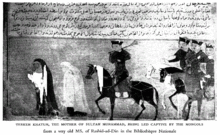Terken Khatun (wife of Ala ad-Din Tekish)
| Terken Khatun | |||||
|---|---|---|---|---|---|
 Terken Khatun captive to Mongols | |||||
| Tenure | 1172 – 1200 | ||||
| Spouse | Ala ad-Din Tekish | ||||
| Issue | Muhammad II | ||||
| |||||
| House | Khwarazmian Empire (by marriage) | ||||
| Father | Kipchak Khan | ||||
| Religion | Islam | ||||
Terken Khatun also known as Turkan Khatun ("the Queen of the Turks") was the Empress of the Khwarazmian Empire as the wife of Shah Ala ad-Din Tekish, and the mother of Muhammad II of the Khwarazmian Empire.[1]
Background
Terken Khatun was from the Qanghli or the Bayads tribe of the Yemek, the daughter of the Kipchak Khan. According to Jalal ad-Din Mingburnu's biographer Muhammad Nasawai, majority of her son, Ala ad-Din Muhammad's, top commanders were from Terken Khatun's tribe, and the need to attach them to his side was one reason why the Shah lent so heavily on his mother for advice.[2]
De-facto co-ruler
After the death of her partner, 'Ala' al-Din Tekish (1172-1200), she so dominated the court of their son, 'Ala' al-Din Muhammad II (1200-20) and quarreled so bitterly with his heir by another wife, Jalal al-Din, that she may have contributed to the impotence of the Khwarazmshahi kingdom in the face of the Mongol onslaught. She had a separate Divan and separate palace and the orders of the sultan were not considered to be effective without her signature. The Shah ruled the heterogeneou peoples without mercy. In face of Mongol attacks, Khwarazm empire, with a combined army of 400.000, simply collapsed. Harezmshah Muhammed had retreated to Samarkand towards the end of his domination and he had to leave the capital city of Gurgenç to her.[3]
References
- ↑ Michal Biran (15 September 2005). The Empire of the Qara Khitai in Eurasian History: Between China and the Islamic World. Cambridge University Press. pp. 165–. ISBN 978-0-521-84226-6.
- ↑ J. A. Boyle, ed. (1968). The Cambridge History of Iran, Volume 5. Cambridge University Press. p. 191. ISBN 978-0-521-06936-6.
- ↑ http://www.guide2womenleaders.com/Iran_Heads.htm